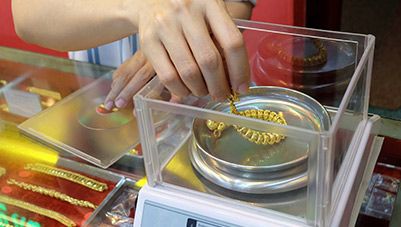Gold making charges are the costs associated with the craftsmanship involved in transforming raw gold into jewellery. These charges cover the labour, design intricacy, and time spent by skilled artisans to create unique jewellery pieces. Unlike the base cost of gold, which fluctuates based on market rates, making charges are relatively stable and vary depending on the complexity and craftsmanship of the design. They are added to the price of gold, making up a significant portion of the final cost of jewellery. Understanding gold making charges is essential for buyers, as they directly impact the overall price of the jewellery.
How Do Gold Making Charges Vary?
Gold making charges vary based on several factors including the type of jewellery, the intricacy of the design, and the reputation of the jeweller. For instance, handcrafted jewellery tends to have higher making charges compared to machine-made items due to the labour-intensive process involved. Additionally, designer pieces or jewellery with intricate detailing and embellishments typically attract higher charges. The geographical location and the jeweller's brand can also influence these charges, with renowned jewellers often charging a premium for their expertise and craftsmanship. Seasonal demands and market trends may further affect the variation in making charges.
Factors influencing gold making charges
Factor |
Description |
Type of Jewellery |
Simple designs have lower charges, while intricate, handcrafted pieces cost more. |
Craftsmanship |
Skilled labour for detailed work increases the making charges. |
Jeweller’s Brand |
Reputed jewellers often charge more due to their brand value and quality assurance. |
Geographical Location |
Making charges can vary regionally due to different market conditions and labour costs. |
Seasonal Demand |
Festive seasons and wedding periods may see higher charges due to increased demand for jewellery. |
Materials Used |
Jewellery incorporating precious stones or additional metals might have higher making charges due to the complexity of the work involved. |
Market Trends |
Current fashion trends and customer preferences can also influence making charges, with trendy designs often attracting higher costs. |
Importance of gold making charges in jewellery pricing
Gold making charges are a critical component in determining the final price of gold jewellery. These charges reflect the craftsmanship, time, and effort invested in creating each piece, thereby adding value beyond the raw material cost. For consumers, understanding these charges is crucial for making informed purchasing decisions and for comparing prices across different jewellers. For jewellers, transparent and fair making charges help build trust and customer loyalty. They also influence the perceived value and exclusivity of the jewellery, especially for handcrafted or designer pieces. Ultimately, making charges bridge the gap between raw gold and a finished piece of art.
Average gold jewellery making charges in India
In India, gold jewellery making charges typically range from 8% to 25% of the gold's value, though this can vary significantly based on the factors mentioned earlier. For instance, machine-made jewellery often has lower charges, around 8-10%, while handcrafted items or intricate designs can attract charges as high as 20-25%. Some premium jewellers may even charge above 25% for exclusive, custom-designed pieces. Additionally, during festive seasons or special promotions, jewellers might offer discounts on making charges to attract customers. It's important for buyers to inquire about these charges and compare across different jewellers to ensure they get the best value for their purchase.
Types of gold making charges
Gold making charges can be classified into different types based on how they are calculated and applied. Understanding these types helps consumers make informed decisions and better manage their jewellery purchases.
Percentage-based making charges
Percentage-based making charges are calculated as a percentage of the gold's value. For example, if the gold rate is Rs. 3,000 per 10 grams and the making charge is 15%, the additional cost would be Rs. 450. This method aligns the making charges with the fluctuating gold prices, making it transparent and straightforward. However, during times of high gold prices, this can significantly increase the final cost of the jewellery.
Fixed making charges
Fixed-making charges are a set amount applied to the creation of the jewellery, regardless of the gold's market value. For example, a jeweller might charge a flat Rs. 200 for a piece of jewellery, irrespective of the gold rate. This method provides consistency and predictability in pricing, making it easier for consumers to budget their purchases. However, it may not reflect the true value of the craftsmanship involved in more intricate designs.
Combination of percentage and fixed making charges
Some jewellers use a combination of percentage and fixed making charges to balance the benefits of both methods. For instance, they might charge a fixed fee for basic designs and a percentage-based fee for more intricate work. This approach allows for flexibility in pricing and ensures that customers are fairly charged based on the complexity of the jewellery. It helps in accommodating various customer preferences and design requirements while maintaining transparency.
Custom gold jewellery making charges
Custom gold jewellery making charges are tailored specifically for bespoke pieces. These charges can be a combination of fixed and percentage-based methods, depending on the agreement between the jeweller and the customer. Custom pieces often involve unique designs and specialised craftsmanship, resulting in higher making charges. This method ensures that the specific needs and preferences of the customer are met, providing a personalised and exclusive jewellery experience.
How gold making charges influence gold loan value?
Gold making charges play a significant role in determining the value of a gold loan. When you pledge your jewellery for a loan, the lender primarily considers the gold content's market value, often excluding the making charges. However, high making charges can increase the overall appraisal of the jewellery, indirectly influencing the loan amount. Jewellery with intricate designs and higher making charges might be appraised at a higher value, leading to a potentially larger loan. Understanding the impact of making charges helps borrowers anticipate the loan amount they can secure, ensuring they receive fair value for their pledged gold.
Using gold jewellery for loans key considerations
When using gold jewellery for loans, there are several key considerations to keep in mind. First, understand the loan against gold process and ensure your jewellery is accurately appraised. It's important to verify the gold loan rate offered by different lenders, as this can vary. Consider the purity and weight of the gold, as higher purity often translates to better loan terms. Additionally, be aware of the lender's terms and conditions, including interest rates and repayment schedules. Choosing a reputable lender and understanding these factors can help you secure the best loan terms and maximise the value of your jewellery.









 Deals starting @99
Deals starting @99 Festive deals
Festive deals Min. 50% off
Min. 50% off
 Wallet to Bank
Wallet to Bank
 Easy EMI Loan
Easy EMI Loan Savings Offer
Savings Offer Smartphones
Smartphones Led TVs
Led TVs Washing Machines
Washing Machines Laptops
Laptops Refrigerators
Refrigerators Air Conditioner
Air Conditioner Air Coolers
Air Coolers
 Loan Against Shares
Loan Against Shares Loan Against Mutual Funds
Loan Against Mutual Funds Loan Against Insurance Policy
Loan Against Insurance Policy ESOP Financing
ESOP Financing Easy EMI Loan
Easy EMI Loan Two-wheeler Loan
Two-wheeler Loan Loan for Lawyer
Loan for Lawyer Industrial Equipment Finance
Industrial Equipment Finance Industrial Equipment Balance Transfer
Industrial Equipment Balance Transfer Industrial Equipment Refinance
Industrial Equipment Refinance Personal Loan Branch Locator
Personal Loan Branch Locator Used Tractor Loan
Used Tractor Loan Loan Against Tractor
Loan Against Tractor Tractor Loan Balance Transfer
Tractor Loan Balance Transfer
 Two-wheeler Loan
Two-wheeler Loan Bike
Bike Scooter
Scooter Electric Vehicle
Electric Vehicle Best Sellers
Best Sellers Popular Brands
Popular Brands

 Trading Account
Trading Account Open Demat Account
Open Demat Account Margin Trading Financing
Margin Trading Financing Share Market
Share Market Invest in IPO
Invest in IPO All stocks
All stocks Top gainers
Top gainers Top losers
Top losers 52 week high
52 week high 52 week low
52 week low Loan against shares
Loan against shares
 Home Loan
Home Loan Transfer your existing Home loan
Transfer your existing Home loan Loan against Property
Loan against Property Home Loan for Salaried
Home Loan for Salaried Home loan for self employed
Home loan for self employed Home Loan EMI Calculator
Home Loan EMI Calculator Home Loan eligibility calculator
Home Loan eligibility calculator Home Loan balance transfer
Home Loan balance transfer
 Term Life Insurance
Term Life Insurance ULIP Plan
ULIP Plan Savings Plan
Savings Plan Family Insurance
Family Insurance Senior Citizen Health Insurance
Senior Citizen Health Insurance Critical Illness Insurance
Critical Illness Insurance Child Health Insurance
Child Health Insurance Pregnancy and Maternity Health Insurance
Pregnancy and Maternity Health Insurance Individual Health Insurance
Individual Health Insurance Low Income Health Insurance
Low Income Health Insurance Student Health Insurance
Student Health Insurance Group Health Insurance
Group Health Insurance Retirement Plans
Retirement Plans Child Plans
Child Plans Investment Plans
Investment Plans
 Business Loan
Business Loan Secured Business Loan
Secured Business Loan Loan against property
Loan against property Loans against property balance transfer
Loans against property balance transfer Loan against shares
Loan against shares Home Loan
Home Loan Loans against mutual funds
Loans against mutual funds Loan against bonds
Loan against bonds Loan against insurance policy
Loan against insurance policy
 Apply for Gold Loan
Apply for Gold Loan Transfer your Gold Loan with Us
Transfer your Gold Loan with Us Gold Loan Branch Locator
Gold Loan Branch Locator
 ULIP Plan
ULIP Plan Savings Plan
Savings Plan Retirement Plans
Retirement Plans Child Plans
Child Plans Free Demat Account
Free Demat Account Invest in Stocks
Invest in Stocks Invest in IPO
Invest in IPO Margin Trading Facility
Margin Trading Facility Fixed Deposit Branch Locator
Fixed Deposit Branch Locator
 Check your Credit Score
Check your Credit Score
 New Car Loan
New Car Loan Used Car Loan
Used Car Loan Loan Against Car
Loan Against Car Car Loan Balance Transfer and Top-up
Car Loan Balance Transfer and Top-up
 Get Bajaj Prime
Get Bajaj Prime
 Mobiles on EMI
Mobiles on EMI Electronics on EMI Offer
Electronics on EMI Offer  Iphone on EMI
Iphone on EMI LED TV on EMI
LED TV on EMI Refrigerator on EMI
Refrigerator on EMI Laptop on EMI
Laptop on EMI Kitchen appliances on EMI
Kitchen appliances on EMI Washing machines
Washing machines
 Personal Loan EMI Calculator
Personal Loan EMI Calculator Personal Loan Eligibility Calculator
Personal Loan Eligibility Calculator Home Loan EMI Calculator
Home Loan EMI Calculator Home Loan Eligibility Calculator
Home Loan Eligibility Calculator Good & Service Tax (GST) Calculator
Good & Service Tax (GST) Calculator Flexi Day Wise Interest Calculator
Flexi Day Wise Interest Calculator Flexi Transaction Calculator
Flexi Transaction Calculator Secured Business Loan Eligibility Calculator
Secured Business Loan Eligibility Calculator Fixed Deposits Interest Calculator
Fixed Deposits Interest Calculator Two wheeler Loan EMI Calculator
Two wheeler Loan EMI Calculator New Car Loan EMI Calculator
New Car Loan EMI Calculator Used Car Loan EMI Calculator
Used Car Loan EMI Calculator All Calculator
All Calculator
 Hot Deals
Hot Deals Clearance Sale
Clearance Sale Kitchen Appliances
Kitchen Appliances Tyres
Tyres Camera & Accessories
Camera & Accessories Mattresses
Mattresses Furniture
Furniture Watches
Watches Music & Audio
Music & Audio Cycles
Cycles Mixer & Grinder
Mixer & Grinder Luggage & Travel
Luggage & Travel Fitness Equipment
Fitness Equipment Fans
Fans
 Personal Loan for Doctors
Personal Loan for Doctors Business loan for Doctors
Business loan for Doctors Medical Equipment Finance
Medical Equipment Finance Secured Business Loan
Secured Business Loan Loan against property
Loan against property Secured Business Loan Balance Transfer
Secured Business Loan Balance Transfer Loan against share
Loan against share Gold Loan
Gold Loan Home Loan
Home Loan
 Engagement Zone
Engagement Zone Game Zone
Game Zone
 Easy EMI Loan
Easy EMI Loan Savings Offer
Savings Offer Smartphones
Smartphones LED TVs
LED TVs Washing Machines
Washing Machines Laptops
Laptops Refrigerators
Refrigerators Air Conditioners
Air Conditioners Air Coolers
Air Coolers Water Purifiers
Water Purifiers Tablets
Tablets Kitchen Appliances
Kitchen Appliances Mattresses
Mattresses Furniture
Furniture Music and Audio
Music and Audio Cameras & Accessories
Cameras & Accessories Cycle
Cycle Watches
Watches Tyres
Tyres Luggage & Travel
Luggage & Travel Fitness Equipment
Fitness Equipment Tractor
Tractor
 Savings Offer
Savings Offer Easy EMI
Easy EMI Offer World
Offer World 1 EMI OFF
1 EMI OFF New Launches
New Launches Zero Down Payment
Zero Down Payment Clearance Sale
Clearance Sale Bajaj Mall Sale
Bajaj Mall Sale
 Articles
Articles
 Overdue Payments
Overdue Payments Other Payments
Other Payments
 Document Center
Document Center Bank details & Documents
Bank details & Documents Tax Invoice Certificate
Tax Invoice Certificate
 Do Not Call Service
Do Not Call Service
 Your Orders
Your Orders Hamara Mall Orders
Hamara Mall Orders

 Fixed Deposit (IFA) Partner
Fixed Deposit (IFA) Partner Loan (DSA) Partner
Loan (DSA) Partner Debt Management Partner
Debt Management Partner EMI Network Partner
EMI Network Partner Become a Merchant
Become a Merchant Partner Sign-in
Partner Sign-in
 Faster, Easier Gold Loan
Faster, Easier Gold Loan Digi Sarkar
Digi Sarkar Used Tractor Loan
Used Tractor Loan Check Loan Offer
Check Loan Offer Mobiles on EMI
Mobiles on EMI ITR
ITR My Garage
My Garage Trade directly with your Demat A/c
Trade directly with your Demat A/c
 Live Videos - Beta
Live Videos - Beta
 New Tractor Loan
New Tractor Loan Used Tractor Loan
Used Tractor Loan Loan Against Tractor
Loan Against Tractor Tractor Loan Balance Transfer
Tractor Loan Balance Transfer























